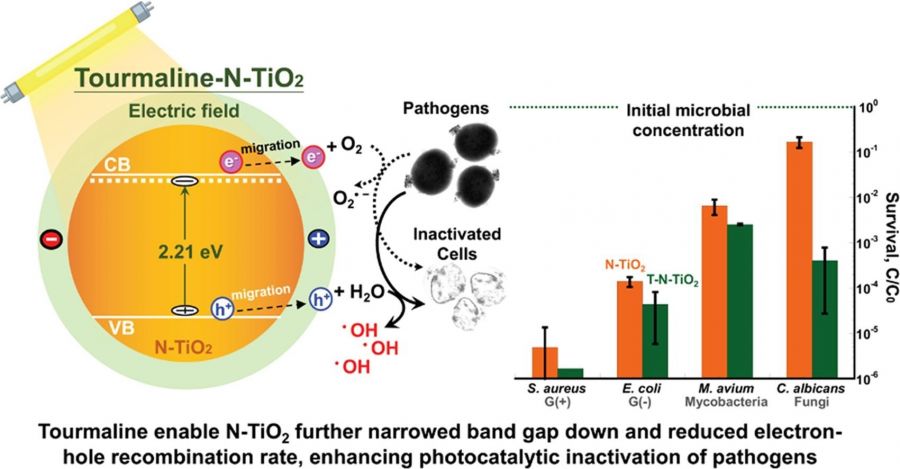新穎材料農業:農業新穎材料在農產品保鮮開發、應用與機理【土壤環境科學系/林耀東特聘教授】
| 論文篇名 | 英文:Inactivation of pathogens by visible light photocatalysis with nitrogen-doped TiO2 and tourmaline-nitrogen co-doped TiO2 中文:氮摻雜二氧化鈦和電氣石-氮共摻雜二氧化鈦可見光光催化滅活病原體 |
| 期刊名稱 | Separation and Purification Technology |
| 發表年份,卷數,起迄頁數 | 2021, 274, 118979. |
| 作者 | Tzeng, Jing-Hua; Weng, Chih-Huang(翁誌煌)*; Yen, Li-Ting; Gaybullaev, Gulomjon; Chang, Che-Jui; de Luna, Mark Daniel G.; Lin, Yao-Tung(林耀東)* |
| DOI | 10.1016/j.seppur.2021.118979 |
| 中文摘要 | 四種病原體,即金黃色葡萄球菌 (S. aureus,革蘭氏陽性菌)、大腸桿菌 (E.coli,革蘭氏陰性菌)、鳥分枝桿 菌(M. avium, 分枝桿菌) 和白色念珠菌 (C. albicans, 真菌) 是導致嚴重人類健康問題的常見微生物。然而,可見光驅動之光催化劑有效滅活病原體仍然是一個挑戰。嘗試比較使用納米級氮摻雜氧化鈦 (N-TiO2) 和電氣石-氮共摻雜氧化鈦 (T-N-TiO2) 在可見光照射下滅活病原體的光催化性能。金黃色葡萄球菌用於比較 N-TiO2 和 T-N-TiO2的光催化滅活性能。研究結果表明,光催化劑用量、初始微生物濃度和可見光強度是影響兩種光催化劑光催化失活過程的關鍵因素。在 3 小時內通過 T-N-TiO2 在 7.25 mW/cm2 可見光照射下實現了對金黃色葡萄球菌的 2-log 滅活,這比通過 N-TiO2 滅活(4 小時)更短。透射電鏡觀察證明,可見光誘導的光催化都會對細胞膜造成嚴重損害。電子順磁共振的結果還表明,在 T-N-TiO2 光滅活系統中產生的羥基自由基越多,可見光誘導的 T-N-TiO2 的滅活性能越好。這是第一項探索光響應改性 Hom 模型 (LHM) 能夠模擬金黃色葡萄球菌的光催化滅活的工作。首先評估了 TN-TiO2 複合材料對 S. aureus、E.coli 和 M. avium 的光催化滅活效果,完全滅活所需的時間順序如下:S. aureus < E. coli < M . avium < C. albicans。我們發現與文獻作品相比,使用 T-N-TiO2 對測試病原體的滅活效率最高。總體而言,在所有測試病原體中,T-N-TiO2 表現出比 N-TiO2 更好的滅活效率。 |
| 英文摘要 | Four types of pathogens, namely, Staphylococcus aureus (S. aureus, gram-positive bacteria), Escherichia coli (E. coli, gram-negative bacteria), Mycobacterium avium (M. avium, mycobacteria), and Candida albicans (C. albicans, fungi), are common microorganisms that cause serious human health issues. However, searching for an efficient material for inactivating pathogens via visible light driven photocatalysts remains a challenge. An attempt was made to compare the photocatalytic performance using nano-sized nitrogen-doped titanium oxide (N-TiO2) and tourmaline-nitrogen-co-doped titanium oxide (T-N-TiO2) for inactivation of pathogens under visible light irradiation. S. aureus was used to compare the photocatalytic inactivation performance of N-TiO2 and T-N-TiO2. The findings showed that photocatalyst dosage, initial microbial concentration, and visible light intensity are the key factors affecting photocatalytic inactivation process for both photocatalysts. A 2-log-inactivation of S. aureus under 7.25 mW/cm2 visible light irradiation via T-N-TiO2 was achieved within 3 h, which is shorter than the inactivation via N-TiO2 (4 h). TEM observations had proved that both visible-light-induced photocatalysis could cause severe damage to the cell membrane. The results of electron paramagnetic resonance also indicated that more hydroxyl radicals generated in the T-N-TiO2 photo-inactivation system allowed a better inactivation per- formance of the visible-light-induced T-N-TiO2. This is the first work exploring that Light-responsive Modified Hom’s model (LHM) is able to simulate photocatalytic inactivation of S. aureus. T-N-TiO2 composite was firstly evaluated for its efficacy of photocatalytic inaction of S. aureus, E. coli, and M. avium, and an increasing order of time was required for complete inactivation as follows: S. aureus < E. coli < M. avium < C. albicans. We have found that the inactivation efficiency of tested pathogens using T-N-TiO2 is the highest as compared with literature works. Overall, T-N-TiO2 exhibits a better inactivation efficiency than that of N-TiO2 in all the tested pathogens. |
| 發表成果與本中心研究主題相關性 | 農業新穎材料在農產品保鮮開發、應用與機理 |







